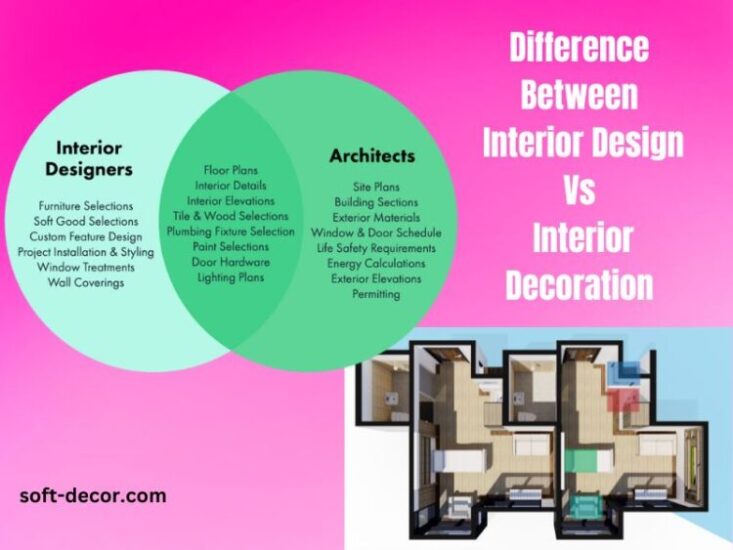When describing the process of creating aesthetically beautiful and functional indoor spaces, the terms “interior design” and “interior decoration” are frequently employed.
Both involve improving the indoor environment, but in very different ways and for very different reasons. This article will look at the differences between interior design and interior decoration, as well as their respective purviews, functions, skill sets, and responsibilities in the change of interior spaces.
Definition of Interior Design
Interior design encompasses both the art and science of improving the indoor environment for health and aesthetic reasons. The process of creating a space such that it meets its purpose while also appearing attractive includes planning, researching, coordinating, and controlling various aspects.
Interior designers work with building contractors and homeowners to create functional and visually beautiful places that fulfill the demands and expectations of their clients.
Definition of Interior Decoration
The aesthetics established by the final placement of furniture, fixtures, and accents in a given area, on the other hand, are the focus of the interior design.
It emphasizes the nuances that enhance the aesthetic value and creates the desired mood. Before picking the proper color palette, material palette, lighting, and accessories, interior decorators meet with their clients one-on-one to learn about their needs and desires.
The Purpose and Scope of Interior Design
During the design phase, the purpose, safety, and efficiency of a location are all considered. Optimizing the use of space necessitates an examination of aspects such as traffic patterns and staff comfort.
Interior designers learn to understand architectural codes, structural limits, and environmental variables in order to meet the demands of people while still adhering to rules. They ensure that new buildings remodel, and renovations are designed in accordance with the overall architectural concept.
Interior Design Goals and Objectives
The major purpose of interior decoration, on the other hand, is to improve the aesthetics and ambiance of a room. Decorators conduct long consultations with their clients to learn about their aesthetic sensibilities, color preferences, and ideal environment.
They accomplish this by carefully selecting and organizing components like as furniture, fabrics, artwork, and accessories. Interior designers are frequently tasked with redecorating an existing room or putting the finishing touches on a completely new structure.
Interior Design Competencies Required
Technical, aesthetic, and social qualities are all required for success in interior design. Designers should be knowledgeable about space planning, architectural concepts, and construction regulations.
They must be skilled communicators and problem solvers in order to work successfully with consumers, architects, and contractors. Furthermore, the ability to create precise blueprints, 3D models, and presentations utilizing computer-aided design (CAD) software is essential.
Decorators Require Specialized Skills and Knowledge
Originality, ingenuity, and precision are valued in the art of interior design. A competent decorator will have a keen sense of color, texture, and proportion.
Space Planning: An Important Aspect of Interior Design
A room’s efficiency and coherence are strongly related to the care and attention provided to its space layout. Professional interior designers thoroughly study a building’s layout, taking into account the needs of the occupants as well as the intended purposes of each area.
To improve efficiency, they create detailed floor plans that illustrate the placement of each piece of furniture, appliance, and architectural feature. Space planners examine elements like foot traffic, room arrangement close to one another, and furniture layout to achieve these aims.
The Importance of Color, Texture, and Materials in Interior Design
Color, texture, and material use are all important aspects of interior design. These are the decorator’s tools, used to catch the eye, set the tone, and create a consistent style. They consider the emotional resonance of colors as well as the relaxing effects of complementary tones.
The texture is used to add depth and tactile interest to surfaces, while materials are chosen for their durability, aesthetic qualities, and suitability for the intended function. By carefully harmonizing a room’s color scheme, furnishings, and accessories, you may radically change its mood and personality.
The Impact of Interior Design on Money and Other Expenses
The prices of interior design and décor can vary greatly. Interior design projects can involve significant structural changes, such as those to walls, ceilings, or electrical systems. These changes necessitate expert knowledge and may raise total costs.
They can, however, boost the property’s long-term value by making it more functional and desirable to buyers if done correctly. Interior design, on the other hand, is primarily concerned with the careful selection and intelligent placement of decorative components.
boost the visual appeal of a room. The final cost of furnishing and adorning a home can vary greatly depending on aspects such as material quality and quantity purchased.
Interior design and decorating on a budget are possible, but only if the consumer knows what is most important to them and communicates those goals to the designer or decorator.
Final Words
In conclusion, while both interior design and interior decoration strive to create aesthetically pleasant settings, they differ in scope, purpose, required talents, and the extent to which the two disciplines collaborate.
Interior designers guarantee that every part of a room performs its intended purpose by collaborating closely with architects and builders.
Interior decorators, on the other hand, are concerned with turning a client’s vision into a reality while paying special attention to aspects such as aesthetics and ambiance. People who have a better awareness of these distinctions will be able to hire the correct professionals to renovate their homes.

